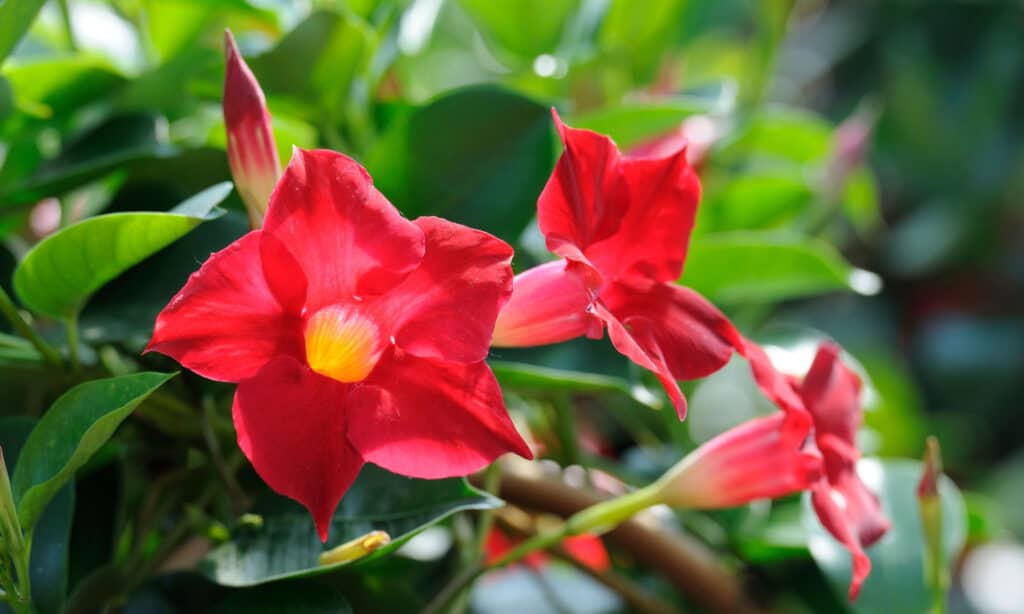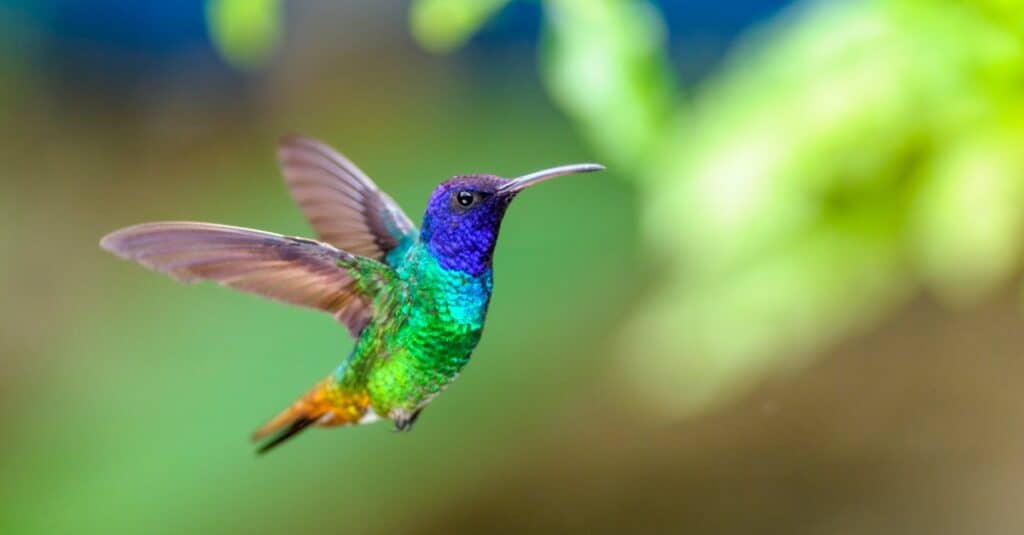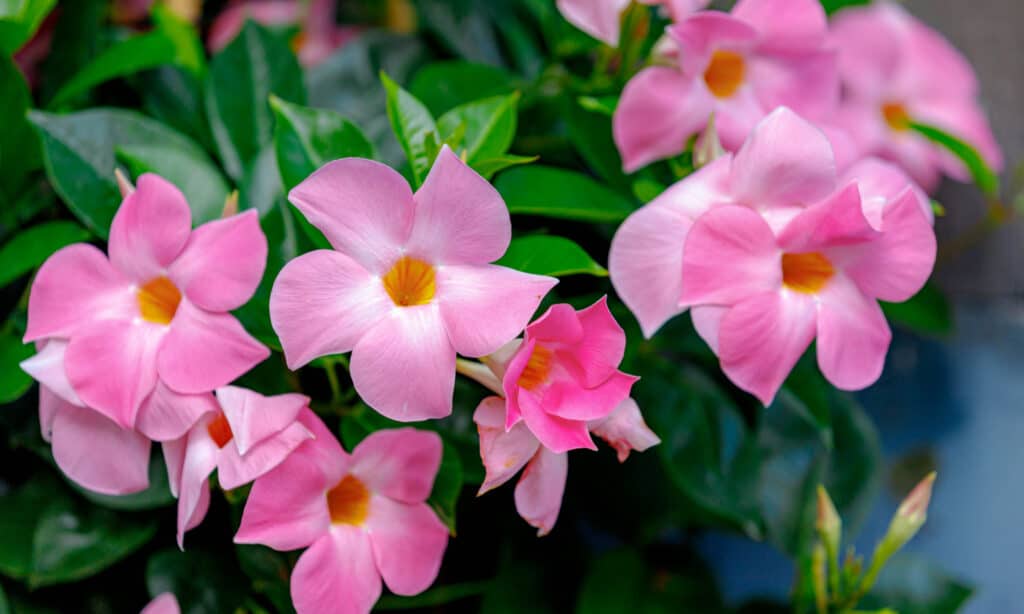Dipladenia is a pretty flowering vine that’s best known as rock trumpet due to its brightly colored trumpet-shaped flowers. It’s a common sight across Central and South America, but is dipladenia a perennial or annual?
Let’s take a closer look at this tropical beauty.
Dipladenia – Perennial Or Annual?

Dipladenias are perennial vines with red, pink, yellow or white blooms.
©HVPMdev/Shutterstock.com
Dipladenia is a perennial vine. Perennial plants grow bigger and produce flowers each year. Other perennial vine favorites include campsis, clematis, bittersweet, and passionflower.
What Is Dipladenia?
Dipladenia is an evergreen perennial vine that’s native to tropical and sub-tropical areas of central and South America.
Dipladenia is a subspecies of mandevilla in the Apocynaceae family. There are around 200 species in this large family! The two are often mixed up or assumed to be the same plant. The main difference is that dipladenia is bushy. It has glossy, smooth leaves up to 8 inches long and 3 inches wide and prefers to grow hanging down. Mandevilla prefers to climb vertically and has longer, thinner leaves in comparison.
Both are tropical vines that need a warm climate. The good news is they have the same growing requirements, so it doesn’t matter if you mix them up!
Here’s an interesting fact. The mandevilla genus was named after Henry Mandeville, who lived from 1773 to 1861. He was a British diplomat and one of the many Victorian-era plant collectors that searched for new species when international travel became easier. Mandeville found mandevilla in Argentina in the 19th century.
What Color Is Dipladenia?

Hummingbirds and large bees pollinate trumpet-shaped dipladenia flowers.
©iStock.com/photofxs68
One of dipladenia’s best aspects is its stunning fragrant flowers. Depending on the variety, it will bloom vivid pink, clean white, buttercup yellow, or intense red. Plant breeders have crossed native varieties many times, so there are lots of different types to buy.
Its flowers have naturally evolved to be trumpet-shaped so larger pollinators can reach inside. Dipladenia flowers throughout the year in tropical countries, so it’s a very useful plant for pollinating bees and hummingbirds.
Is Dipladenia Evergreen or Deciduous?
Dipladenia is evergreen. It keeps its foliage all year round in warm areas. In cooler areas, it’ll drop some of its leaves. It’s a perennial plant that retains its foliage depending on the local climate. It’s evergreen in its native habitat.
Should Dipladenia Be Cut back?
Yes. Cut back dipladenia for lots of flowers. It naturally flowers on the current year’s growth. It’s a tall grower that can reach 20 feet, so the top part often can’t be seen unless it’s pruned back!
For the best-looking plant, cut it back by a third each year. This encourages bushy growth with flowers on eye level. It’s best to cut it back in early spring or even late winter and trim excess growth anytime if it gets too big.
Do You Deadhead Dipladenia?
Yes! Deadheading Dipladenia’s old wilted flowers encourage more flowers. Dead flowers are best snapped off by hand, but they can be cut off with secateurs too.
Another way to encourage more flowers is to fertilize the soil. This is especially important for container-grown dipladenia. Use a high phosphorus fertilizer with a 10-30-20 mix or close to it. Add half a teaspoon to a gallon of water and mix it up well.
Slowly watering dipladenia is best. Let the fertilized water sink into the ground before adding more. Otherwise, it runs off the soil.
Can Dipladenia Be Planted In The Ground?
Dipladenia is a versatile perennial plant. It grows best in the ground, where it has ready access to water and nutrients, but because it’s drought tolerant, it also thrives in large, well-watered, and fed containers such as deck boxes, window boxes, and hanging baskets.
In colder climates, it’s best to put dipladenia in a container, so it’s easier to move it indoors before the cold weather arrives.
What Do You Do With Dipladenia in the Winter?
Dipladenia is a tropical plant that needs lots of warmth. In tropical and sub-tropical areas, it will grow outside during winter. In cold areas with frost, it should be brought indoors to a conservatory or glasshouse.
Can Dipladenia Be A Houseplant?

Dipladenia can be grown indoors.
©Wut_Moppie/Shutterstock.com
Yes, Dipladenia can be a houseplant, and it’s best grown inside in cold climates because frost can kill it. In the United States, zones 9-10 are warm enough to grow outdoors. It will drop leaves in zone 8. Anything below zone 8, and it’s best grown indoors.
As a houseplant, dipladenia needs lots of light and regular fertilizer. It’s best to avoid scorching sunlight that can damage its foliage. The best spot is bright, indirect window light away from cold drafts.
So, is dipladenia a perennial or annual? Well, we’ve discovered it’s a perennial and a beautiful one too! In tropical climates, it’s evergreen. But in cold climates, it’s best grown as a houseplant. With the right amount of warmth, perennial dipladenia will last for years.
Is Dipladenia Poisonous To Pets?
The ASPCA doesn’t list it as a poisonous plant, but eating any part of it, including foliage, stems, roots, or flowers, might cause digestive problems. Its sap can also cause some irritation. This isn’t unusual. Many plants have sap that causes irritation, it’s a way of protecting themselves from hungry animals, much like the heat response in chili peppers!
Up Next
The photo featured at the top of this post is © Wut_Moppie/Shutterstock.com
Thank you for reading! Have some feedback for us? Contact the AZ Animals editorial team.






